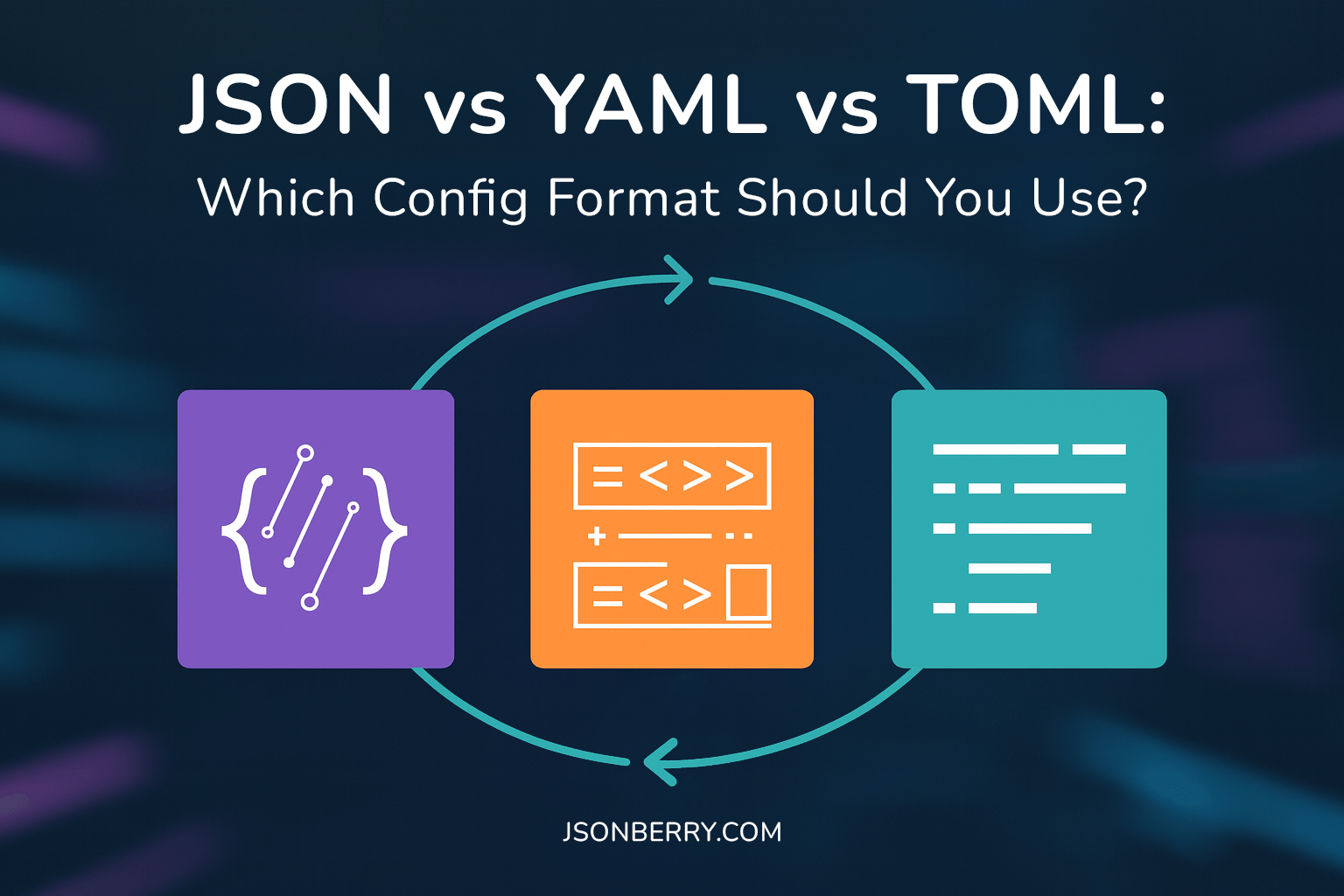Article
JSON vs YAML vs TOML: Which Config Format Should You Use?
Compare JSON, YAML, and TOML for configuration files. Learn their pros, cons, and best use cases, and see how Jsonberry makes format conversion effortless.

- #json vs yaml vs toml
- #configuration files
- #json config
- #yaml config
- #toml config
- #devops tools
- #python pyproject.toml
- #rust cargo.toml
- #config best practices
- #jsonberry
Configuration files keep modern stacks in sync. Whether you maintain a Python package, deploy to Kubernetes, or tune a Rust toolchain, you are going to bump into JSON, YAML, and TOML on a weekly basis. This guide breaks down how the formats differ, where each one shines, and how to stay flexible when projects switch directions.
What Are JSON, YAML, and TOML?
- JSON (JavaScript Object Notation) is the lightweight, language-agnostic data exchange workhorse with strict syntax and zero surprises at runtime. Learn more in the JSON data interchange standard.
- YAML (YAML Ain’t Markup Language) prioritizes human readability and supports comments, anchors, and complex structures. The YAML specification documents the full feature set.
- TOML (Tom’s Obvious, Minimal Language) focuses on clarity for project-level configuration. It aligns closely with INI familiarity while remaining explicit. Visit the TOML syntax guide for authoritative references.
Side-by-Side Comparison
| Feature | JSON | YAML | TOML |
|---|---|---|---|
| Readability | Medium - braces and quotes keep structure explicit | High, but whitespace drives structure | High - deliberate, predictable layout |
| Ease of Writing | Commas and quotes are mandatory | Flexible yet prone to indentation mistakes | Very approachable - minimal punctuation |
| Parsing Support | Universal across languages and tooling | Strong, but behavior varies by parser | Expanding across Rust, Python, and more |
| Best Use Cases | APIs, telemetry payloads, machine-to-machine data | DevOps manifests, pipeline definitions, IaC templates | Project config files such as `pyproject.toml` or `Cargo.toml` |
| Common Pitfalls | Trailing commas and lack of comments | Invisible whitespace issues and implicit type casting | Smaller ecosystem and fewer ready-made snippets |
When to Use Each Format
JSON - Best for Data Exchange
- Universally supported in browsers, runtimes, and databases.
- Perfect for APIs, telemetry payloads, or handoffs between services.
- Tooling rarely misinterprets JSON because the syntax is strict.
{
"name": "my-app",
"version": "1.0.0"
}YAML - Best for Complex Configurations
- Friendly for humans and flexible enough for layered DevOps configs.
- Supports anchors, aliases, and comments for living documentation.
- Watch out for indentation slips or implicit type conversions.
dependencyChecks:
plan: nightly
notify: team-devops@example.comTOML - Best for Human-Edited Project Files
- Keeps configuration readable without relying on whitespace sensitivity.
- Ideal for Python, Rust, and cross-language toolchains that store metadata in repos.
- Decouples humans from parser quirks while keeping types explicit.
[tool.poetry]
name = "my-app"
version = "1.0.0"Pros and Cons at a Glance
JSON
✔ Fast, portable, and easy to integrate with existing APIs.
✘ Editing by hand is tedious and comments are not allowed.
YAML
✔ Expressive, readable, and supports comments alongside config.
✘ Invisible whitespace errors trigger painful debugging sessions.
TOML
✔ Predictable syntax for humans and CI pipelines alike.
✘ Fewer copy-paste examples and snippets compared with JSON or YAML.
Real-World Example
Imagine an AI pair programmer ships a JSON snippet for your plugin manifest, but your repo requires pyproject.toml. Translating by hand risks typos across dozens of keys. Instead, open the Jsonberry converter in a separate tab, paste the JSON on the left, and trigger the TOML output with Ctrl or ⌘ + Enter. Because the tool runs fully in your browser and never uploads content, your sensitive configuration stays private while you get a validated TOML file in seconds.
Conclusion
Choosing between JSON, YAML, and TOML comes down to the kind of collaboration and automation you need. Keep these quick cues in mind:
- Reach for JSON when interoperability and machine parsing come first.
- Pick YAML when teams co-edit orchestration files and need comments close to config.
- Choose TOML for repository configs that humans revisit regularly.
As requirements shift, lean on the Jsonberry JSON ↔ TOML converter to keep format changes private, accurate, and fast.